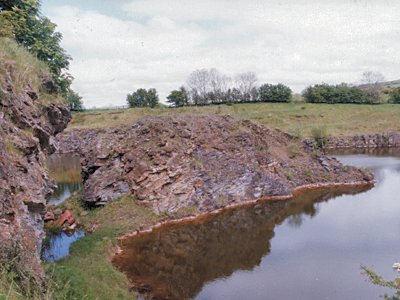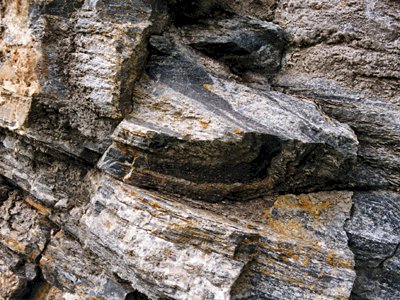Earth Science Conservation Review
| Drain Quarry | Tyrone |
| Site Type: | Quarry (disused) |
| Site Status: | ESCR |
| Grid Reference: | C458019 |
| Google maps: | 54.86319,-7.28673 |
| Rocks | |
|---|---|
| Rock Age: | Precambrian (Dalradian) |
| Rock Name: | Alla Glen Limestone Member, Claudy Formation |
| Rock Type: | Limestone |
| Interest | |
Summary of site:
On the west side of the disused, flooded quarry at Drain extensive outcrops of the Alla Glen Limestone (the lowest part of the Claudy Formation) can be seen. It appears in coarse grained, grey to greyish-blue beds, up to 1m thick (often described as ‘sugary' in appearance), separated by thin altered shale partings (phyllites and pelites) less than 1cm thick. Both rocks contain the soft, silvery mica muscovite, and cubes and encrustations of fool's gold (pyrite).
The rocks have been deformed during their metamorphism (alteration by heat and pressure, deep below ground surface) and show cleavages and folds with a strong southerly shear. The rocks lie on the north-west side of the huge, 40km-wide Sperrin overfold, facing upwards (the south-east limb of the fold is overturned).
Despite their altered state, it is clear that these rocks, around 600 million years old, were originally limestones (probably organic) and formed in a shallow marine environment, close to land. They were severely deformed and altered around 465 million years ago during the Grampian orogeny, a time of continental collision.
It has been proposed that the Alla Glen Limestone Member is equivalent in age to the base of the Dart Formation on the south-east, overturned limb of the Sperrin fold, despite their different nature. This is possible because the Dart Formation could have been formed at the same time but much further offshore.
The limestones in the Claudy Formation are strongly characterised, which means that they can be recognised in widely separated outcrops and used to correlate rock sequences over considerable distances. They also assist in interpreting the heavily buckled and contorted rock structures.
The Drain Quarry exposures are particularly important because so few outcrops exist and here sufficient rock can be seen to work out often fairly difficult problems, even allowing interpretation of original sedimentary features.
The flooding of the quarry restricts access to all but the faces on the west side, where the main interest lies. Instability here requires particular care. Future threats are likely to be a higher water table, leading to flooding and dumping.
The rocks have been deformed during their metamorphism (alteration by heat and pressure, deep below ground surface) and show cleavages and folds with a strong southerly shear. The rocks lie on the north-west side of the huge, 40km-wide Sperrin overfold, facing upwards (the south-east limb of the fold is overturned).
Despite their altered state, it is clear that these rocks, around 600 million years old, were originally limestones (probably organic) and formed in a shallow marine environment, close to land. They were severely deformed and altered around 465 million years ago during the Grampian orogeny, a time of continental collision.
It has been proposed that the Alla Glen Limestone Member is equivalent in age to the base of the Dart Formation on the south-east, overturned limb of the Sperrin fold, despite their different nature. This is possible because the Dart Formation could have been formed at the same time but much further offshore.
The limestones in the Claudy Formation are strongly characterised, which means that they can be recognised in widely separated outcrops and used to correlate rock sequences over considerable distances. They also assist in interpreting the heavily buckled and contorted rock structures.
The Drain Quarry exposures are particularly important because so few outcrops exist and here sufficient rock can be seen to work out often fairly difficult problems, even allowing interpretation of original sedimentary features.
The flooding of the quarry restricts access to all but the faces on the west side, where the main interest lies. Instability here requires particular care. Future threats are likely to be a higher water table, leading to flooding and dumping.
| Enlander, I., Dempster, M. & Doughty, P., 2025. Drain Quarry, County Tyrone, site summary. [In] Earth Science Conservation Review. https://www.habitas.org.uk/escr/summary.php?item=147. Accessed on 2025-04-03 |
| Previous Site | Next Site |

